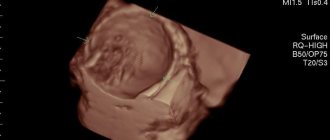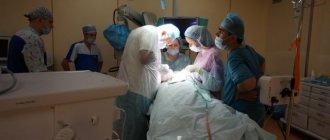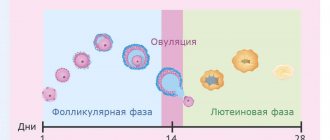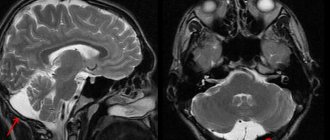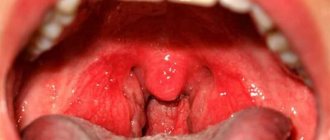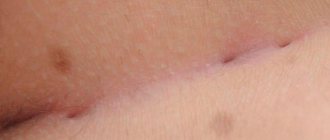An ovarian cyst is a cavity filled with contents. This benign disease can be congenital or acquired. Cystic formations are detected in women of different age groups, and even girls who are not sexually active.
Often the disease is asymptomatic, without causing discomfort, and is detected during an ultrasound examination.
What is a cyst
The content of the article
More than a third of women of all ages develop neoplasms in the ovaries, namely cysts. An ovarian cyst is a neoplasm located on the wall of an organ and filled with fluid. In most cases, a woman does not even suspect that any disturbances have occurred in her body.
Cysts can be dangerous and harmless. Safe (functional - small, without inclusions of pathological cells) disappear over time and have virtually no effect on a woman’s life. Other types of tumors are dangerous to health and must be removed surgically. If you delay treatment for an ovarian cyst, remember about possible complications: the development of a malignant tumor, suppuration and rupture of the cyst, followed by peritonitis.
Causes
The main reason for the formation of cysts is hormonal changes in the body associated with endocrine diseases, ovarian dysfunction and other changes, such as age-related ones.
It is noted that cysts often occur after abortions, stress and other traumatic factors. All the causes of cysts have not yet been precisely studied, but it is known that they are provoked by:
- inflammatory processes in the ovaries;
- sexual infections;
- Ovarian endometriosis is a disease in which cells from the uterus (endometrium) enter the ovarian tissue;
- congenital abnormalities of the reproductive system;
- termination of pregnancy, especially those carried out by surgical curettage;
- excess weight;
- metabolic diseases;
- imbalance of sex hormones.
Functional neoplasms
When diagnosing functional formation, 90% use conservative methods. It uses hormonal drugs that affect the follicular and luteal capsules. Gynecologists most often choose progesterone-based tablets “Regulon”, “Janine”, which reduce the concentration of estrogen in the blood. After treatment, to stabilize hormonal levels, Duphaston courses are prescribed for up to 2 months.
Sometimes experts may recommend using traditional medicine methods. Most often this is brewing infusions of chamomile, calendula and other herbs that help activate the immune system and reduce pain. But traditional medicine methods are used exclusively in an auxiliary role and cannot replace drug treatment.
It is important to take into account that after 50 years, functional cysts do not form, which is due to physiological changes in the female body. At this age, the risk of malignancy of other types of formations is highest.
Acquired ovarian cysts
- Follicular
- occurs if the follicle does not rupture and the egg does not come out. During ultrasound, they can be observed on both ovaries. Sometimes there are several such formations. - Endometrioid cysts
are manifestations of ovarian endometriosis. They are formed from endometrial uterine cells that enter the ovary. These cellular structures react to hormonal changes caused by the menstrual cycle - they increase in size before the onset of menstruation, and then begin to bleed. There is nowhere for the released blood to flow out, so it forms cysts, which are called “chocolate” due to the coagulated dark bloody contents. - Corpus luteum cysts
occur due to hormonal imbalances. After the follicle emerges, the corpus luteum produces progesterone for some time, which is necessary for pregnancy. But, if conception does not occur, this formation should resolve. Sometimes this does not happen and a cystic formation forms in the ovary. Sometimes the formation reaches a large size and begins to bleed. - Cysts in polycystic disease
can be multiple. Polycystic ovarian syndrome is associated with metabolism, so women experience infertility, miscarriages, cardiovascular disease, diabetes and even mental illness.
Prevention
As a preventative measure, experts insist on an annual examination by a doctor and diagnostic tests. This will help detect pathology in the early stages and eliminate it with minimal consequences for health.
You need to be examined regularly, regardless of age. According to research, dysontogenetic formations formed during the period of intrauterine development can be found in girls. And in women during menopause, organic cysts are often detected.
It is worth avoiding the influence of provoking factors:
- Hormonal imbalances.
- Abortions.
- Decreased immunity.
This will help prevent the development of formation and the occurrence of other pathological processes. In addition, doctors recommend:
- Take hormonal medications only as directed.
- Receive timely treatment for diseases of the reproductive system.
- Avoid the influence of stress.
- To refuse from bad habits.
It is important to adhere to proper nutrition, which will prevent weight gain and normalize hormonal levels. To stabilize hormonal levels, nutritionists recommend including in your daily diet:
- Raw or stewed vegetables.
- Apples, berries.
- Dairy products.
- Lean meat and fish.
In this case, you will have to give up carbonated drinks, fast food, sweets, fatty and fried foods.
Congenital ovarian cysts
- Dermoid
, formed from embryonic glandular tissue. These formations may contain hair, fat, teeth, cartilage, and bone tissue. Dermoid cysts can reach a size of 25 cm. Although malignant degeneration of the cyst occurs only in 1-2 percent of cases, a large tumor puts pressure on neighboring organs, causing pain and dysfunction; - Paraovarian cysts
, arising from embryonic tissue, are located next to the ovaries. The reason for their appearance is a violation of the intrauterine formation of the girl’s internal genital organs. Paraovarian cysts grow very slowly, but can reach enormous sizes (up to 30 cm).
Diagnosis of cysts
In order for the gynecologist to determine whether the patient has a cyst, he first of all conducts an examination and sends her for an ultrasound examination of the pelvic organs. If the ultrasound does not give accurate results, then the following procedures are performed:
- Ultrasound of the ovaries;
- blood tests for biochemistry and tumor markers;
- test to determine the presence of pregnancy, including ectopic.
Additional studies performed to diagnose complications associated with the formation of an ovarian cyst:
- a urine test is carried out to find out whether the patient is losing blood during the day (in addition to the days of menstruation);
- puncture of the posterior vaginal vault to determine whether there was hemorrhage in the abdominal area;
- laparoscopic examination.
Why is an ovarian cyst dangerous?
Ovarian cysts increase in size, interfering with the work of neighboring organs. By disrupting the functioning of the reproductive system, they often cause infertility. Sometimes cysts develop into cancer.
The most serious complication of these formations is rupture of the membrane, in which the cystic contents leak into the abdomen. The woman has to undergo emergency surgery to remove the tumor capsule, often including part of the ovary. Torsion of cysts that have a “leg” is no less dangerous. There is a disturbance in blood flow, accompanied by tissue necrosis. Without treatment, this complication is fatal.
In order not to endanger life and health, it is necessary to identify and treat ovarian cysts in a timely manner.
Complications
A functional ovarian cyst, which is treated in a timely manner, does not cause any complications and rarely recurs. In the absence of therapy and an unfavorable course, the risk of developing complications such as:
- cyst rupture;
- leg torsion;
- intra-abdominal bleeding.
All of these conditions require emergency medical attention. If you self-medicate at home, complications arise that threaten not only the health, but also the life of the patient.
What do normal ovaries look like during ultrasound examination?
Normally, during an ultrasound examination, both ovaries are almost the same size:
- length – 30-41 mm;
- width – 20-31 mm;
- thickness – 14-22 mm;
- volume - about 12 cubic ml.
Due to the maturing follicles, the surface of the organ looks bumpy. Since the ovary is well supplied with blood, its tissues contain many blood vessels.
Typically, at least 12 cells mature in two ovaries. Among them stands out a dominant follicle measuring 10-22 mm, from which an egg will be released in the middle of the cycle. If ovulation has already passed, the corpus luteum is visible inside the ovary, secreting hormones necessary for implantation and development of the embryo. If conception does not occur, the corpus luteum dissolves.
What do the ovaries look like with cysts?
Ultrasound examination allows not only to identify cystic formations, but also to determine their type. Sometimes this requires several ultrasound examinations at different periods of the menstrual cycle:
- A dermoid cyst
has quite dense contents, so it looks lighter than others. Areas of heterogeneous structure are found inside. The walls of the formation are quite thick - 7-12 mm. Since the cyst grows very slowly, repeated ultrasound on any day of the menstrual cycle does not reveal changes in its size and structure. - A paraovarian cyst
is located outside an unchanged ovary. As a rule, it is single-chamber. Its size and appearance do not change depending on the day of the menstrual cycle. - The endometrioid cyst
has a smooth, clear shape. Wall thickness 2-9 mm. Inside there are structures that have a high density and resemble a honeycomb. Therefore, on the screen the cyst looks like a dark formation separated by light areas. The eggs in such an organ do not mature, but the other healthy ovary works normally. Before the critical days, the size of the cyst increases. In parallel, an enlargement of the uterus may be observed. - The follicular ovarian cyst
has thin walls and an even dark color. It is common - these neoplasms account for up to 20% of cases of ovarian tumors. In most cases, it gradually decreases in size, as can be seen on a repeat ultrasound. Sometimes follicular cysts do not resolve, being found even in women with long-extinct menstrual function. - A corpus luteum cyst
is similar in appearance to a follicular cyst. To differentiate them, Doppler ultrasound is performed. On examination, a bright circle is visible around the cystic formation, which doctors call the “ring of fire.” There is no blood flow inside the cystic formation itself.
What to do if you find a cyst in the ovary
Detection of an ovarian cyst during an ultrasound is not a reason to panic. Small tumors can often be cured by prescribing hormonal drugs and vitamins A, B, and C. Under the influence of medications, the size of the tumor decreases over several menstrual cycles.
It is better not to touch small congenital cysts that are not disturbing or growing. You just need to visit a doctor and do an ultrasound to monitor the tumor. To exclude malignant degeneration, it is necessary to periodically donate blood for tumor markers.
When planning a pregnancy, it is better to get rid of the cyst, because... it may begin to grow or burst during a period when surgery is unsafe. After a properly performed operation, cysts do not recur. But women prone to the appearance of such formations should be observed by a gynecologist.
Doctor's opinion
In advanced cases, with severe complications, oophorectomy is performed according to indications, when the ovary is removed along with the formation, although this is rare in the functional type.
Rehabilitation after laparoscopy takes only 2–3 weeks. All this time, the patient is observed by the attending physician, control ultrasound diagnostics, anti-inflammatory and symptomatic therapy are carried out. The patient must follow medical recommendations, avoid physical activity and exercise, do not take a hot bath, refuse other thermal procedures, avoid sex for a while, and adhere to the recommended diet. Control ultrasonography should be performed 2 months after surgical treatment. — Butunov Alexey Andreevich Obstetrician-gynecologist, laparoscopist surgeon, oncologist. Doctor of the highest category.
Features of treatment of ovarian cysts
The following factors influence which treatment method the doctor chooses: the woman’s age, parameters of the ovarian cyst, the general health of the patient, and concomitant diseases. Treatment of the cyst may initially be hormonal, then laparoscopic.
Functional cysts are treated with hormonal therapy and, if the method does not bring results, the patient is sent for surgery, which can be performed either laparoscopically or laparotomically. If the presence of a cyst is dangerous to life and health, the woman is urgently operated on.
Growing dermoid, paraovarian and endometrioid cysts are removed laparoscopically through small incisions in the anterior abdominal wall. Modern methods make it possible to remove cysts while preserving the ovary, which is important for women planning to have children in the future.
After surgery, the gynecologist prescribes a course of treatment to restore the proper functioning of the woman’s reproductive system. In addition to medications, hirudotherapy (intravaginal) and homeopathic medications are often prescribed. If the patient is overweight, a nutritionist and endocrinologist are involved in the treatment process.
If the patient is planning to have children, surgery to remove the cyst cannot in any way affect the likelihood of conception. In extreme cases, operations are performed even during pregnancy. Sometimes this does not affect the development of the fetus, but, in rare cases, there is a need to terminate the pregnancy, since the threat to the life and health of the mother is extremely high.
Hormonal drugs
Conservative treatment is based on the use of various combinations of hormonal drugs. Gynecologists prescribe the following groups of drugs:
- If there is a deficiency or excess of hormones - “Duphaston”, “Urozhestan”.
- If it is necessary to reduce the level of the hormone that provokes the growth of formation - “Diane”, “Janine”, “Regulon”.
- To eliminate inflammatory processes - “Indomethacin”.
- To eliminate pathogenic microflora - “Vancomycin”, “Lincomycin”.
- To stimulate the immune system – “Timalin”.
To normalize hormonal levels and regression of education, specialists prescribe oral contraceptives. For treatment, a special drug regimen is developed. In some cases, COC therapy is combined with the use of gestagens, which block the pituitary gland and promote temporary replacement of hormones with artificial derivatives.
The drug Duphaston with the main active ingredient – Dydrogesterone – has proven itself especially well. The drug is actively used for the treatment of follicular formations and endometriosis. In the first case, it promotes the correct transition from the first to the second phase of the menstrual cycle, and in the second, it prevents the growth of the endometrium and the appearance of new capsules.
This drug is prescribed only by a doctor, who determines the dose and treatment regimen based on:
- Data obtained during the inspection.
- Nature of the pathology.
- Age.
- Analysis results.
In some cases, after taking large doses of the drug, side effects are observed, such as migraines, rashes, bleeding. But with proper treatment and dose selection, hormonal levels are normalized and the cycle improves.
If the inflammatory process or cyst formation is caused by pathogenic microflora, the doctor may prescribe broad-spectrum antibiotics that can eliminate diseases of the reproductive system.
If the urinary system is disrupted, diuretics are prescribed, and if the formation is inflamed, anti-inflammatory drugs are prescribed. Additionally, agents that enhance immunity are used, for example, folic acid, vitamin C, E. To minimize pain, use Diclofenac or No-shpa.
To enhance the effect of medications, various physiotherapeutic treatment methods are prescribed. Most often used:
- Electrophoresis.
- Ultraphonoresis.
These procedures make it possible to enhance the effect of medications, normalize the function of the damaged organ, and prevent the development of inflammation. Physiotherapy is also used during the recovery period to reduce the likelihood of relapse, improve blood circulation and other factors.
